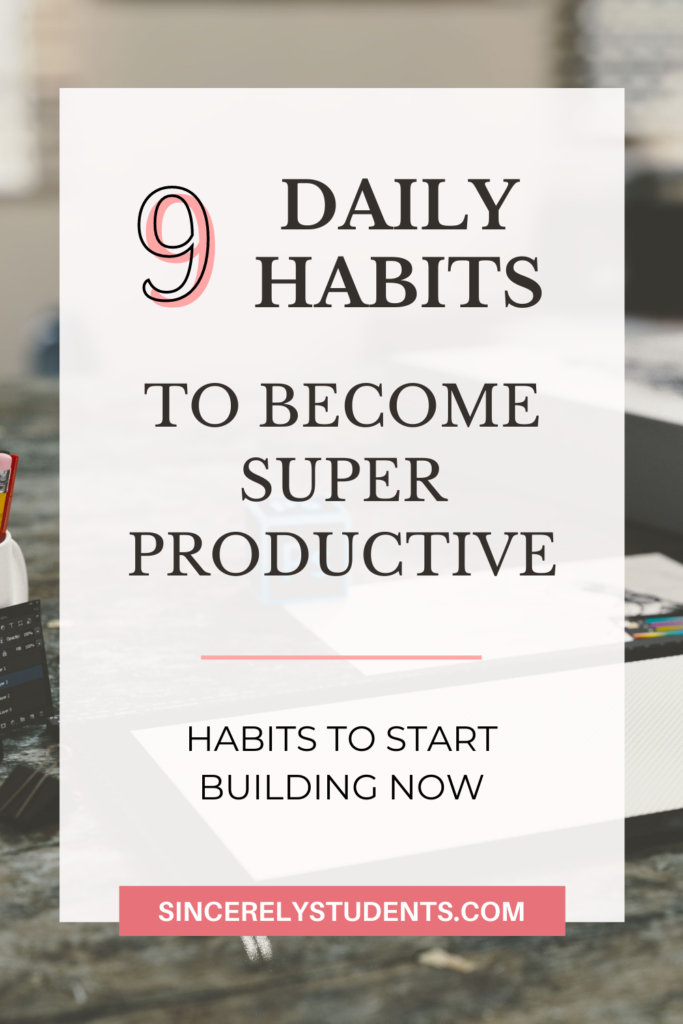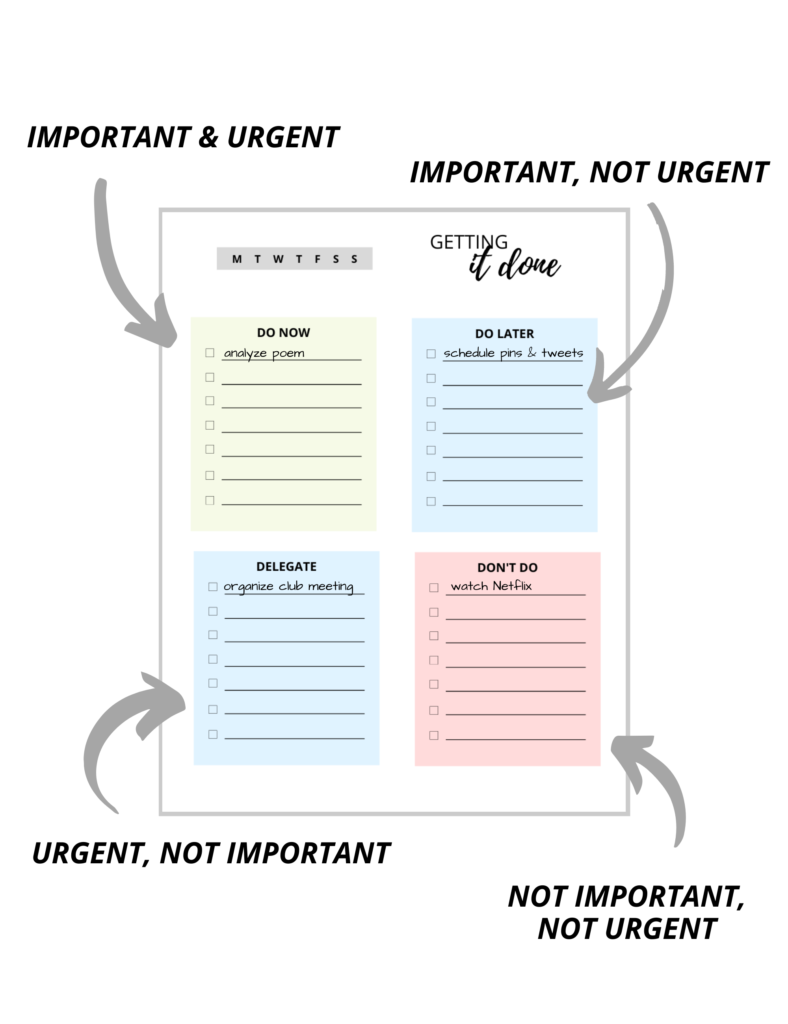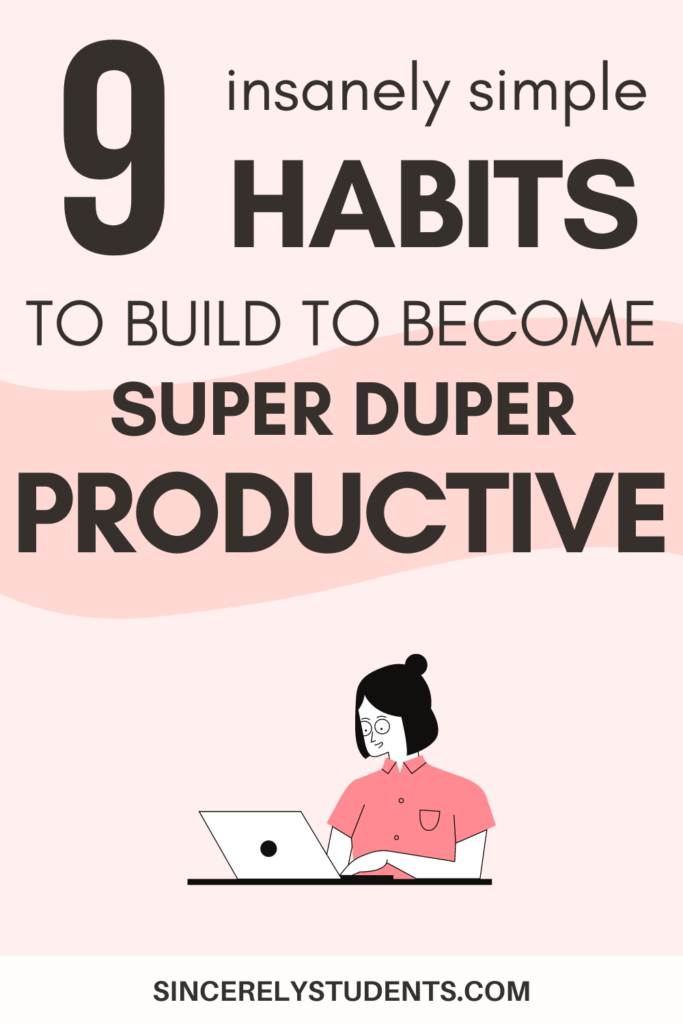Do you ever wonder, “how do they do everything?”. Successful people seem to be everywhere at once, being productive and getting things done all the time.
Though this may not be true (even the most productive people take breaks), there are indeed things they do differently than you.
In this post, you’ll learn 9 daily habits of productive people and what exactly you can do on the daily basis to become productive.

One thing at a time
Productive people don’t multitask (usually). Sure, it’s great to listen to a podcast or read a book while you’re eating breakfast, but don’t watch TV while you’re doing homework.
Though it may feel like you’re “maximizing your time” by doing multiple things at once, you’ll just be distracted and not carry out either task as well as you wish.
Instead, focus on 1 task at a time and aim to finish it completely in a predetermined block of time. Essentially, you need to schedule a block of time and dedicate that to 1 entire task.
You can do this in your calendar (through time-blocking), your planner, or even just a paper to write down a to-do list, which brings us to our next habit.
Make to-do lists
Try to make to-do lists every evening for the following day. This is a crucial step towards planning ahead consistently, which is an important habit to build if you want to be productive and organized.
Planning ahead– whether it’s for the following day, week, month, or even year– allows you to be accountable and structured in your actions.
You also don’t have to worry about “what should I do now?”, because everything you need to do is already laid out for you, and you just have to tackle them. Usually, if you follow your to-do list diligently and complete it, you’ll have time left over to relax.
You can make to-do lists in any way you prefer. During the day (when I’m assigned homework), I jot them down on my computer. For more important tasks that may take me longer to complete, I write them down in my planner.
The MUJI Free Monthly Planner is one of my favorite planners to use, as it’s undated (so I can start any time in the year), allows for monthly and weekly planning, is incredibly simplistic, and has space for freedom.
Though it is relatively expensive for a planner, it is extremely high-quality and durable. Check it out below! And if you’d like a cheaper (and reusable) alternative, you can check out the Ultimate 3-in-1 Student Planner, made by me!
Batch and prioritize tasks
Batching and prioritizing your tasks go hand in hand with creating your to-do list. When creating your to-do list (or when you’re reviewing it in the morning), decide which tasks go together and which tasks should be prioritized.
It should be easy to decide which tasks should be “batched.” You can batch them together based on the following criteria:
- Purpose (school, work, personal…)
- Location (at home, at the library…)
- Type of work done (taking notes, research…)
Once you batch similar tasks together, you’ll be able to go from one to the next without losing much concentration and time. So while writing or reviewing your to-do list, organize the individual tasks and put similar ones next to each other.
In addition, you must learn to prioritize and determine what tasks are the most important and should be done first. To do this, use an Eisenhower Matrix to characterize individual tasks.

Based on these 2 criteria (urgency and importance), you can determine a certain order in which you should complete your tasks. By following this order, you will ensure that you complete all the most important tasks first and are the most productive.
YOU’LL LOVE THIS POST: Ultimate 5 Day Guide To Become Insanely Productive
Eat the frog
In your to-do list, there may be a difficult task that you aren’t particularly eager to tackle. However, as difficult as these tasks are, you must complete them eventually. And instead of procrastinating on them, “eat the frog”!
Find the times during the day when you are most energetic, concentrated, and productive (your peak times!), and dedicate that time to completing the most difficult task.
Determining your peak times can take some trial and error. You may be more productive during the morning on some days, and during the afternoon on other days. Therefore, try to identify a pattern and find your peak times.
Limit social media
Contrary to what others may tell you, you do not have to completely eliminate social media or other distractions on your phone. Instead, simply limit the time you spend on them and how often you visit them.
2 of the most effective ways to do this are to turn off notifications and to use productivity apps like Forest or Flora.
You are not obligated to open every single notification and reply to every message. However, with the notifications that are sent to your phone, you may feel like it.
However, even if you don’t have notifications on, you might feel the urge to open Instagram and Twitter every once in a while. Though this is extremely normal for teens today, it is a terrible habit.
To break this bad habit, you can download an app like Forest ($1.99) or Flora (free). With these apps, you can “plant a tree” and set a period of concentration. During the time, you must not use your phone, or the tree will die.
Forest and Flora are almost a fun game to play, except they help you maximize your time instead of wasting it. Check them out on the app store!
Take breaks
Taking breaks is inevitable. Even if you plan to be super productive, you’ll want to take breaks as you work. Therefore, just know that it’s okay to take breaks.
But don’t take breaks whenever you want, at random intervals. This will only result in more distraction and less productivity. Instead, schedule them into your day.
Remember your time-blocked schedule? Don’t completely fill up your schedule with your to-do list. Leave intervals (around 10-15 minutes) of nothing to allow yourself a short break between tasks.
A more structured way to do this is to practice the Pomodoro method. Work for 25 minutes, then rest for 5 minutes. You can try this method and customize it for yourself. I like to work until I finish a task, then take a short break. This way, I won’t break concentration while working on a task but can still take a break.
Have timely meals
Snacking can become a distraction while you’re working, especially if the snack is “messy.” To prevent yourself from getting hungry while working and snacking, you need to make sure you’re having timely meals.
Even if you’re incredibly busy during the day, try to whip up a quick meal. You can buy frozen, ready-made meals from local grocery stores, and prepare them as a meal during the day.
Get enough sleep
In addition to all these actionable habits to become productive during the day, you must also get enough sleep during the night. If you don’t get enough sleep at night, you’re more likely to feel tired during the day and lose focus while working.
The ideal sleep schedule for students is to get at least 8 hours of sleep at night. Depending on when you need to wake up in the morning, this could mean sleeping between 10-11:30 pm. Though this differs between each person, you should definitely try to build and follow a consistent and healthy sleep schedule.
Write things down before bed
Last but not least, build the habit of writing things down before going to sleep. There is nothing you truly have to write down, but there are some that are incredibly helpful to have.
Some things you can write include:
- A diary entry of the day’s events
- Your plans for the next day
- A to-do list for the next day
- What is on your mind to declutter it
- A journal entry for personal growth
- Anything you want to write down!
Conclusion
I hope these tips were helpful for you to become more productive! With these 9 daily habits, you’ll be one step closer to becoming a successful person who can get everything done on time!
If you’re looking for more posts like this:
- 7 Terrible Study Habits To Quit Immediately
- 5 Stupid Simple Lists Every Student Should Be Making
- How To Set Up Your Planner For Maximum Productivity
